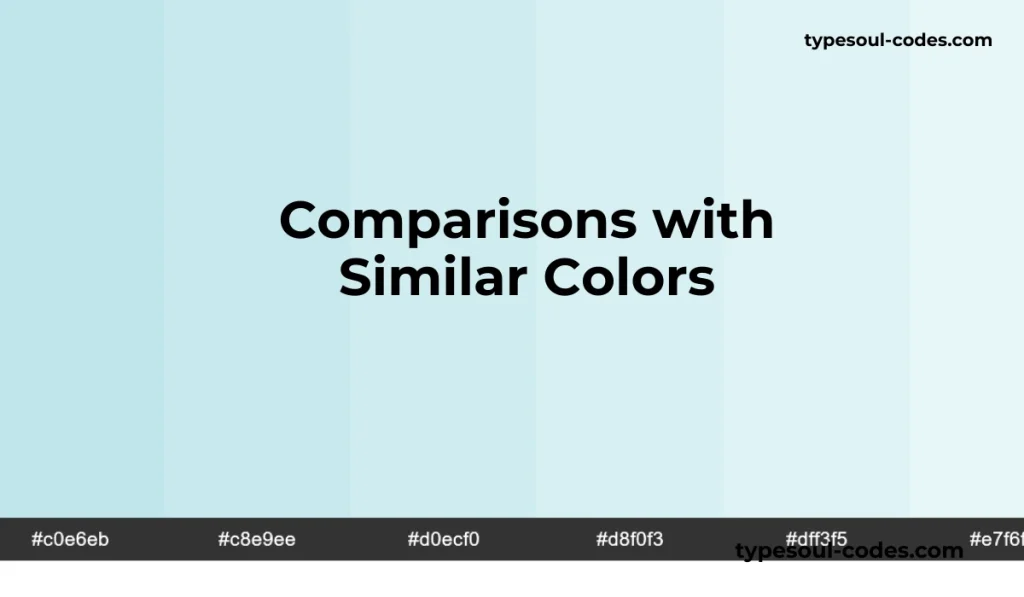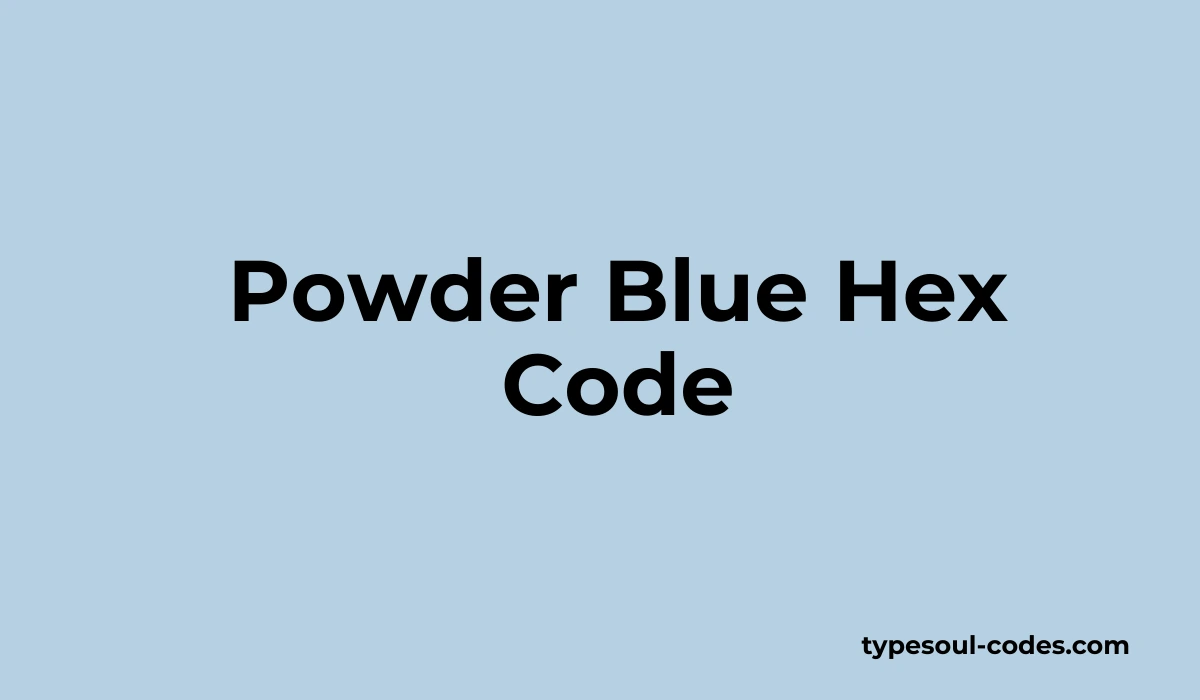Powder blue is one of the most calming and elegant shades in the color world. Many designers, web developers, and branding experts turn to this color when they want to create a soothing experience. The Powder Blue Hex Code plays a vital role in bringing this shade to life on digital platforms.
The term “powder blue” originally referred to powdered cobalt glass, which was used in fabric dyeing centuries ago. Over time, the name evolved into a color definition used across web and design projects. The most commonly recognized powder blue hex code is #B6D0E2, although some sources may list other close variants.
What Is Powder Blue?
Powder blue is a pale, soft blue with a slight grey undertone. It sits in the blue-green area of the color wheel and brings a gentle, relaxed mood to any design. Designers often use this color in backgrounds, soft branding elements, or even in children’s product packaging. The powder blue hex code helps maintain color consistency across websites, apps, and print media.
Historical Context of Powder Blue
The name powder blue has roots going back to the 17th century. It originally described a fine blue powder made from cobalt glass. This powder was used to brighten laundry and color textiles. The current use of powder blue hex code reflects a modern take on that historical shade. Over time, the name moved from referring to a material to describing a color used widely in visual projects.
| Feature | Details |
| Hex Code | #B6D0E2 |
| Emotional Value | Calm, Trust, Peace |
| Design Uses | UI, Print, Branding |
| Best Pairing Colors | White, Navy, Pink |
| Main Benefit | Gentle, Elegant Tone |
Read more: Star stable redeem codes
Digital Representation of Powder Blue
Every digital color has a specific code that helps devices display it accurately. The powder blue hex code is used in HTML, CSS, and various graphic design tools to ensure uniformity.
Here are the most common digital values for powder blue:
| Format | Value |
|---|---|
| HEX | #B6D0E2 |
| RGB | 182, 208, 226 |
| HSL | 205°, 43%, 80% |
| HSV | 205°, 19%, 89% |
| CMYK | 19%, 8%, 0%, 11% |
Designers and developers often rely on the powder blue hex code to match the desired shade without errors. This helps maintain brand consistency and visual balance.
Symbolism and Emotional Value
Colors have psychological effects, and powder blue is no different. It represents peace, trust, and cleanliness. Many tech brands and healthcare companies use light blue shades to communicate safety and reliability. The powder blue hex code allows brands to evoke these emotions on websites, apps, and advertisements.
Using powder blue creates a sense of calm and order. It is often used in wellness apps, spa branding, and baby-related products. Its light tone helps reduce visual noise and makes content easy on the eyes.
Powder Blue in UI and UX Design
When building user interfaces, the Powder Blue in UI and UX Design works well as a background or secondary color. Its low saturation means it won’t overpower the main content. Designers use it to separate content sections subtly or provide a clean, non-distracting canvas.
One important thing to consider is contrast. Since powder blue is light, text or icons placed on top of it should be darker. This ensures that designs are accessible and meet contrast standards like WCAG 2.1. Tools like Figma offer contrast checkers that are useful when working with the blue hex code.
Comparisons with Similar Colors

Powder blue can sometimes be confused with sky blue, baby blue, or misty blue. These shades are all light, but they differ slightly in hue, saturation, and brightness. The powder blue hex code helps remove this confusion by offering a precise value.
| Color Name | Hex Code | Difference |
| Powder Blue | #B6D0E2 | Muted and soft |
| Sky Blue | #87CEEB | Brighter and vibrant |
| Baby Blue | #89CFF0 | Slightly warmer |
| Misty Blue | #B4CFD3 | More greyish tone |
Understanding these differences allows designers to pick the right blue for their projects. The powder blue hex code offers a balance between vibrancy and subtlety.
Pairing Powder Blue with Other Colors
To create a beautiful color palette, powder blue can be paired with neutrals, warm tones, or other cool hues. Pairing it with white or light gray gives a clean, minimalistic look. When used with dusty pink or tan, it creates a soft, romantic mood.
Designers also like combining powder blue with deep colors like navy, forest green, or charcoal. These combinations help create depth while keeping the design peaceful. The blue hex code serves as a base for many modern palettes in web and branding design.
Print and Branding Applications
In print design, powder blue is used in brochures, packaging, and business cards. Since the blue hex code is digitally defined, printers convert it using CMYK values. The code ensures that colors in the final print closely match the digital version.
For branding, this shade works well for industries like health, wellness, finance, and childcare. It provides a non-aggressive and welcoming presence. Brands that want to be seen as friendly and reliable often include this color in their palette.
Powder Blue in Fashion and Interiors
Outside of digital and branding design, powder blue is also trendy in fashion and interior design. Clothing designers use this shade in summer collections due to its light and airy feel. Interior designers use it for bedrooms, nurseries, and offices to promote calm and focus.
When the powder blue hex code is applied to smart lighting or digital home accessories, it enhances the relaxing ambiance. It brings a soft touch that works well with wood, metal, or modern plastic textures.
Read more: Maytag error codes
Tools to Use with Powder Blue Hex Code
Popular tools like Canva, Adobe Illustrator, and Figma let you paste the powder blue hex code directly. This helps you instantly apply the color to your shapes, fonts, backgrounds, and illustrations. Websites like coolors.co and Adobe Color Wheel help build entire palettes around the code.
Frequently Asked Questions
What is the hex code for powder blue?
The most accurate hex code is #B6D0E2.
Can I use powder blue in branding?
Yes, it is popular for wellness, tech, and childcare branding due to its calming effect.
What colors go best with powder blue?
It pairs well with white, navy, tan, dusty pink, and light gray.
Is powder blue good for accessibility?
Yes, if paired with high-contrast elements like dark text or icons.
Conclusion
In conclusion, the powder blue hex code is essential for designers looking to create calming, modern, and professional designs. Its historical roots and versatile application make it a timeless choice in both digital and print media. By using the hex code #B6D0E2, you ensure consistency, clarity, and emotional appeal in every visual project you craft.

